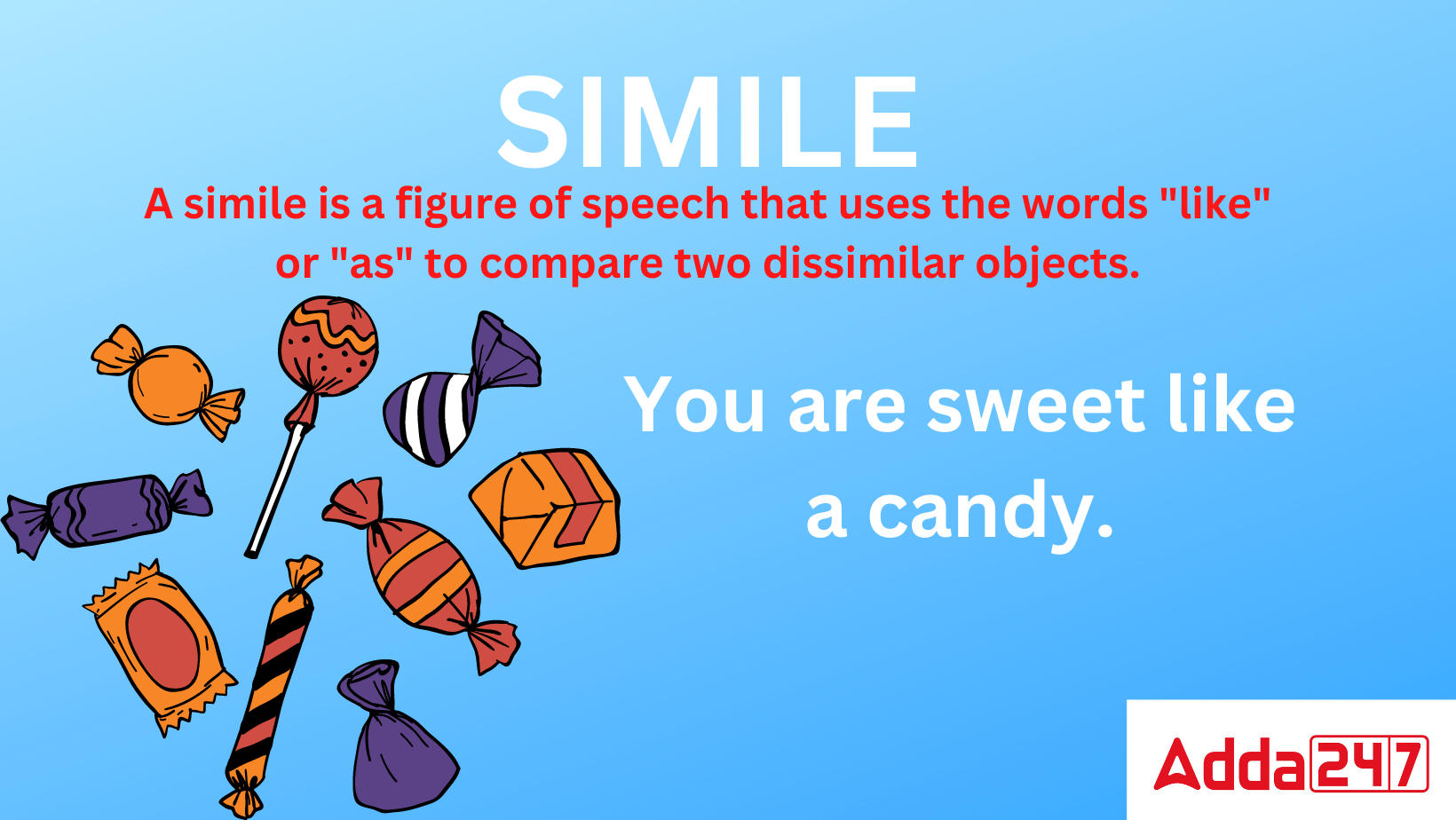Simile
A simile is a figure of speech that uses the words “like” or “as” to compare two dissimilar objects. The adverbs “cool as a cucumber,” “cold as ice,” and “sly as a fox” are examples of common similes.
Simile Figure of Speech
Simile poetic devices are frequently used by authors to bring concrete pictures to writing about abstract subjects. For instance, Winston Groom used the metaphor “life is like a box of chocolate” in his 1986 book Forrest Gump. Similes are a fantastic technique to add excitement and memory to creative writing without losing focus.
Similes Poetic Device
Simile is a poetic device where “like” or “as” is used to compare two different objects and demonstrate a shared feature between them. In contrast to a straightforward comparison, a simile typically contrasts two unconnected objects. She looks like you, for instance, is a comparison rather than a simile. She grins like the sun, on the other hand, is a simile since it compares a lady to something quite different—the sun.
Simile Meaning in English
Simile Meaning in English. The basic purpose of a simile, which is a figure of speech, Simile is to compare two or more items that have comparable quality. It compares things using words like “like” or “as.”
Simile Definition
A simile is described as “a term or phrase that compares something to something else, using the words like or as” in the Oxford Learner’s Dictionary. A simile is described as “a term comparing one thing with another, always incorporating the words as or like” by the Cambridge Dictionary. According to the Collins Dictionary, a simile is a term that portrays a person or thing as being comparable to someone or something else. A simile is “a figure of speech comparing two, unlike objects that is frequently presented,” according to the Merriam-Webster Dictionary.
Simile Meaning and Examples
Simile is to compare two or more items that have comparable quality. It compares things using words like “like” or “as.” Here are some examples of similes to help you understand how similes are formed and how they can be used in sentences.
Similes using ‘as’
- As slow as a sloth
- As busy as a bee
- As innocent as a lamb
- As proud as a peacock
- As fast as a cheetah
- As blind as a bat
- As bold as brass
- As cold as ice
- As white as a ghost
- As tall as a giraffe
- As sweet as sugar
- As strong as an ox
- As old as the hills
- As cool as a cucumber
- As clear as a crystal
- As tough as leather
- As good as gold
- As light as a feather
- As thin as a rake
- As deep as the ocean
- As cunning as a fox
- As clean as a whistle
- As sharp as a razor
- As gentle as a lamb
- As bright as the moon
Similes using ‘like’
- Jumps like a frog
- Sings like a cuckoo
- Runs like the wind
- Nocturnal like an owl
- Have eyes like a hawk
- Runs like a horse
- Swim like a fish
- Climbs like a monkey
- Sleeps like a baby
- Fighting like cats and dogs
- Fall like teardrops
- Eat like a pig
- Like a box of chocolates
- Slept like a log
- Chatters like a monkey
- Move like a snail
- Fit like a glove
Simile Uses
When comparing two or more nouns in a sentence, a simile is typically utilised, and this is accomplished by using words like “like” or “as.” The general idea behind using the word “as” in a simile is to use a noun that is well-known for a specific feature. For instance, “as busy as a bee” or “as proud as a peacock,” etc. A simile is a straightforward comparison of two like or disparate items. A simile aids the reader or listener in picturing, comprehending, and developing a better understanding of the characteristics of the words being compared. It becomes much more vivid and descriptive as a result. Alternatively put, similes can be employed to provide a mental image to your reader or listener.
Simile vs Metaphor
Both metaphors and similes are examples of figurative language and sorts of comparison. Although a simile is a sort of metaphor, there is a significant distinction between these two literary concepts. When two unconnected objects are compared, the words “like” or “as” are used. A direct parallel is made for rhetorical impact in a metaphor, on the other hand.
However, metaphors specifically use one thing to depict another. Similar to simile, these figurative descriptions are employed to gain symbolic effect and can help to make ideas clearer, highlight minor connections, or develop gripping images. The verbs is, are, and was frequently indicate metaphors (e.g., “She is a star”), but this is not always the case (e.g., “path to freedom”). The simile places two ideas side by side; in the metaphor, they become layered, as writer F.L. Lucas puts it.
Simili Meaning in Hindi
एक उपमा भाषण का एक अलंकार है जो दो भिन्न वस्तुओं की तुलना करने के लिए “पसंद” या “जैसा” शब्दों का उपयोग करता है। क्रिया विशेषण “एक ककड़ी के रूप में ठंडा,” “बर्फ के रूप में ठंडा,” और “एक लोमड़ी के रूप में चालाक” आम उपमाओं के उदाहरण हैं। अमूर्त विषयों के बारे में लिखने के लिए ठोस चित्र लाने के लिए लेखकों द्वारा समान काव्य उपकरणों का अक्सर उपयोग किया जाता है। उदाहरण के लिए, विंस्टन ग्रूम ने अपनी 1986 की किताब फॉरेस्ट गंप में “जीवन चॉकलेट के एक डिब्बे की तरह है” रूपक का इस्तेमाल किया। उपमा ध्यान केंद्रित खोए बिना रचनात्मक लेखन में उत्साह और स्मृति जोड़ने की एक शानदार तकनीक है।
Simili Meaning in Hindi-पोएटिक डिवाइस
उपमा एक काव्य उपकरण है जहां “पसंद” या “जैसा” दो अलग-अलग वस्तुओं की तुलना करने और उनके बीच एक साझा विशेषता प्रदर्शित करने के लिए उपयोग किया जाता है। एक सीधी तुलना के विपरीत, एक उपमा आमतौर पर दो असंबद्ध वस्तुओं के विपरीत होती है। उदाहरण के लिए, वह आपकी तरह दिखती है, उपमा के बजाय तुलना है। दूसरी ओर, वह सूरज की तरह मुस्कुराती है, यह एक उपमा है क्योंकि यह एक महिला की तुलना बिल्कुल अलग चीज़ से करती है – सूरज।
Simili Meanind and Definition with Examples in Hindi
एक उपमा का मूल उद्देश्य, जो अलंकार है, दो या दो से अधिक वस्तुओं की तुलना करना है जिनकी गुणवत्ता तुलनीय है। यह “like” या “as” जैसे शब्दों का उपयोग करके चीजों की तुलना करता है।
ऑक्सफोर्ड लर्नर्स डिक्शनरी में एक उपमा को “एक शब्द या वाक्यांश के रूप में वर्णित किया गया है जो किसी चीज़ की तुलना किसी और चीज़ से करता है, जैसे या जैसे” शब्दों का उपयोग करता है। कैम्ब्रिज डिक्शनरी द्वारा एक उपमा को “एक चीज की तुलना दूसरे के साथ तुलना करने वाला शब्द, हमेशा शब्दों को शामिल करने या पसंद करने” के रूप में वर्णित किया गया है। कोलिन्स डिक्शनरी के अनुसार, उपमा एक ऐसा शब्द है जो किसी व्यक्ति या वस्तु को किसी व्यक्ति या किसी अन्य चीज़ के साथ तुलनीय होने के रूप में चित्रित करता है। मेरियम-वेबस्टर डिक्शनरी के अनुसार एक उपमा “दो की तुलना करने वाली भाषण की एक आकृति है, जो अक्सर प्रस्तुत की जाने वाली वस्तुओं के विपरीत होती है”।
Simili Definition and Examples in Hindi
उपमाओं के कुछ उदाहरण आपको यह समझने में मदद करते हैं कि उपमाएँ कैसे बनती हैं और वाक्यों में उनका उपयोग कैसे किया जा सकता है।
‘as’ का प्रयोग करते हुए उपमाएँ
आलस्य जितना धीमा
बहुत व्यस्त
मेमने की तरह मासूम
मोर के समान गर्वित
चीते जितना तेज़
चमगादड़ जितना अंधा
पीतल की तरह बोल्ड
बर्फ की तरह ठंडा
भूत जैसा सफेद
जिराफ जितना लंबा
शक्कर जितनी मीठी
बैल की तरह मजबूत
जितनी पुरानी पहाड़ियाँ
खीरे की तरह ठंडा
क्रिस्टल की तरह स्पष्ट
चमड़े की तरह सख्त
सोने जितना अच्छा
पंख की तरह हल्का
रेक जितना पतला
सागर जितना गहरा
लोमड़ी की तरह चालाक
सीटी की तरह साफ
उस्तरे जितना तेज
मेमने की तरह कोमल
चाँद की तरह चमकीला
‘पसंद’ का उपयोग कर उपमा
मेंढक की तरह उछलता है
कोयल की तरह गाती है
हवा की तरह दौड़ता है
उल्लू की तरह निशाचर
बाज जैसी आंखें हों
घोड़े की तरह दौड़ता है
मछली की तरह तैरना
बंदर की तरह चढ़ता है
बच्चे की तरह सोता है
बिल्लियों और कुत्तों की तरह लड़ना
आंसुओं की तरह गिरना
सुअर की तरह खाओ
चॉकलेट के डिब्बे की तरह
एक लॉग की तरह सोया
बंदर की तरह बकबक करता है
घोंघे की तरह चलो
दस्ताने की तरह फिट
उपमा उपयोग
एक वाक्य में दो या दो से अधिक संज्ञाओं की तुलना करते समय, एक उपमा का आमतौर पर उपयोग किया जाता है, और यह “लाइक” या “एज़” जैसे शब्दों का उपयोग करके पूरा किया जाता है। एक उपमा में “as” शब्द का उपयोग करने के पीछे सामान्य विचार एक संज्ञा का उपयोग करना है जो एक विशिष्ट विशेषता के लिए प्रसिद्ध है। उदाहरण के लिए, “मधुमक्खी के रूप में व्यस्त” या “मोर के रूप में गर्व” आदि। उपमा दो समान या असमान वस्तुओं की सीधी तुलना है। एक उपमा पाठक या श्रोता को चित्रित करने, समझने और तुलना किए जा रहे शब्दों की विशेषताओं की बेहतर समझ विकसित करने में सहायता करती है। परिणामस्वरूप यह बहुत अधिक जीवंत और वर्णनात्मक हो जाता है। वैकल्पिक रूप से, उपमाओं को आपके पाठक या श्रोता को एक मानसिक छवि प्रदान करने के लिए नियोजित किया जा सकता है।
Simili Meaning in Hindi- उपमा बनाम रूपक
रूपक और उपमा दोनों आलंकारिक भाषा और तुलना के प्रकार के उदाहरण हैं। यद्यपि एक उपमा एक प्रकार का रूपक है, इन दो साहित्यिक अवधारणाओं के बीच एक महत्वपूर्ण अंतर है। जब दो असंबद्ध वस्तुओं की तुलना की जाती है, तो “लाइक” या “एज़” शब्दों का उपयोग किया जाता है। दूसरी ओर एक रूपक में आलंकारिक प्रभाव के लिए एक सीधा समानांतर बनाया जाता है।
हालाँकि, रूपक विशेष रूप से एक चीज़ का दूसरे को चित्रित करने के लिए उपयोग करते हैं। उपमा के समान, इन आलंकारिक विवरणों को प्रतीकात्मक प्रभाव प्राप्त करने के लिए नियोजित किया जाता है और विचारों को स्पष्ट करने, मामूली कनेक्शनों को उजागर करने, या मनोरंजक छवियों को विकसित करने में सहायता कर सकता है। क्रियाएं हैं, हैं, और अक्सर रूपकों को इंगित करती थीं (उदाहरण के लिए, “वह एक सितारा है”), लेकिन यह हमेशा मामला नहीं होता है (उदाहरण के लिए, “स्वतंत्रता का मार्ग”)। उपमा दो विचारों को साथ-साथ रखती है; रूपक में, वे स्तरित हो जाते हैं, जैसा कि लेखक एफ.एल. लुकास डालता है।
Know more:
| Simile | Antithesis |
| Metaphor | Oxymoron |
| Personification | Epigram |
| Apostrophe | Irony |
| Alliteration | Pun |
| Assonance | Metonymy |
| Hyperbole | Synecdoche |
| Euphemism | Transferred Epithet |









 HPBOSE Compartment Date Sheet 2025 Out, ...
HPBOSE Compartment Date Sheet 2025 Out, ...
 RUHS Counselling 2025 Round 1 Seat Allot...
RUHS Counselling 2025 Round 1 Seat Allot...
 Bihar Board Dummy Registration Card 2026...
Bihar Board Dummy Registration Card 2026...










